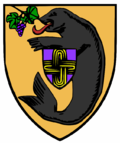Haifa
 Flag | |
 Coat of Arms | |
| Motto: | "Veritas nos elegit" (Truth Chose Us) |
| Capital | Abeis |
| Largest Cities | Keybir-Aviv, Lewisburg, |
| Official Languages | Common Tongue, Haifan, Pallisican |
| Demonym | Haifan |
| Government | The Government of the State of Haifa |
| Head of State | Díapaza Bréidle |
| Head of Government |
|
| Legislature | Strait of Haifa Investment Committee |
| Population | 20,678,067(39.20 PSSC) |
Etymology
There are two main hypothesis of how the name Haifa came about. One hypothesis is that the name relates to the Haifan (Hebrew) root, CHFA, which means “to cover, to hide”, perhaps because of Lake Morovia being "hidden" in the middle of the Keltian continent. Another interpretation links the name with the word CHOF, beach, or “beautiful beach.”
History
Haifa was founded over the course of several decades by serial migratory waves of Hammish citizens from the state of Anglia and Israat along the shores of Lake Morovia. During their migration, they came into contact with several indigenous groups to the area, which led to their mixing over several generations and creating a distinct Haifan culture. It became an independent state called the Free State of Haifa under the leadership of its first Prime Minister, Herman Wozhleweitz.
Free State of Haifa
During its founding years, Haifa was mainly an agricultural nation. That changed when enormous deposits of diamonds and other gems south of the city of Abeis. Under the leadership of its second Prime Minister, George Perlman, the Free State built a thriving banking and finance sector as the economy liberalized and the economy became flush with the proceed of economic growth and mining.
- Prime Minister Ismael Todochev
- Afrikaans immigration
- Subsequent Prime Ministers
- Closing Years, Collapse of the Free State
Haifa as part of Hamland
Hammish Civil War
See also: Hammish Civil War.
Haifa as part of Caputia
The state of Haifa was the third largest state in the Kingdom of the Union of Caputia by population. Abeis was the most populous city in Caputian Haifa and among the largest in Caputia, while Keybir-Aviv was second-most populous in the state. Other major cities included Lewisburg and Melusinia. Haifa under Caputian rule was nicknamed "The Free State" to signify its former status as an independent republic and as a reminder of the state's struggle during the Hammish Civil War.
Historically four major industries shaped the Haifan economy under Caputian rule: diamond mining, agriculture, banking and finance, fishing, and technology. With a growing base of industry, the state led in many industries, including agriculture, jewelry, computers and electronics, aerospace, and biomedical sciences.
Rise of Haifan nationalism
The period of Caputian rule in Haifa was defined by the rise of Haifan nationalism, a political movement that first began during the Hammish Civil War, which sought the re-establishment of an independent Haifan nation. The rise of Haifan nationalism was heavily and forcefully opposed by the government of Caputia, which correctly assessed that the political movement was a product of foreign interference campaigns spearheaded the Haifo-Pallisican Imperial Trade Union. The heavy handed response of the Caputian government, which included policies that denied citizenship to any person who practiced the native religion of the Haifan people, that sought the deportation of the practitioners of the Haifan religion, and which disenfranchised Haifan voters who expressed support for independence, did little to quell the growth of Haifan nationalism. Rather, most Haifan nationalists found their resolve strengthened by such measures, which they regarded as pure manifestations of the corrupt and oppressive system of foreign governance from which they sought independence. When in 38.25 PSSC the government of Caputia announced that it would reject the outcome of a referendum in which Haifans voted in favor of independence, these Haifan nationalists - whose resolve had been strengthened by the heavy-handed policies enacted by the Caputian government - rose up in violent revolt. This rebellion set the stage for the Haifan civil war, which would occur in the immediate aftermath of the dissolution of the Caputian government, and the subsequent annexation of Haifa by the Haifo-Pallisican Imperial Trade Union.
Bassarid annexation and civil war
Geography
Climate and Topography
Demographics
Region Statistics
Note: Haifa is represented on the Port of Vines by the West Keltian Relief Fund .
| Year | Population | Growth (Growth %) | Food Imports (/Person) | Fuel Imports (/Person) | Other Imports (/Person) | Immigration Modifier (%) | Seats in Regional Government | Seats in Houses of Corum
|
|---|---|---|---|---|---|---|---|---|
| 39.20 PSSC | 20,678,067 | N/A (N/A%) | 17,58,998 (.9) | 1,102,893,543 (4.93) | 37,509,515 (1.81) | .13 | N/A | N/A |